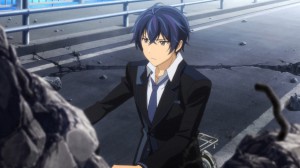written by Laurie Tom
April means the start of the spring anime season, and this time around there looks to be an unusually large crop of shows I want to try out. I generally don’t end up watching everything I try out all the way through, but to give an idea of what’s out there, here’s a snapshot of which first episodes I watched, why I chose them, and what I thought of them.
By quirk of luck, everything I want to check out this season is streaming exclusively at Crunchyroll for American viewers, with the exception of M3: the dark metal, which is at Daisuki..
Black Bullet
Why I Watched It: I really liked the promo art. The premise is that ten years ago humanity came under attack of the Gastrea Virus, which mutates humans into giant insect monsters. Though humans were eventually able to find a sense of stability again, outbreaks can still happen and are held in check by teams of Promoters and Initiators. Initiators are Cursed Children who were born from infected mothers and Promoters are their handlers.
What I Thought: Rentaro, the Promoter main character doesn’t break any new ground, but he’s just belligerent enough, just competent enough, and just likeable enough to keep me engaged. Unfortunately due to the timeline of the show his Initiator sidekick Enju has to be an elementary school girl, but she’s not written like one and her constant attempts to be Rentaro’s intimate girlfriend might eventually turn me off the show. It’s only “funny” because she’s ten. If she was older it would be sexual harassment. (Rentaro is clearly not interested.) I’m not sure what the greater plot is from the first episode, which features the duo taking out a final stage infected before it can cause an outbreak, but I like Rentaro and his friend Kisara (who I think has a nice chemistry with him) enough that I’ll give Black Bullet another go.
Verdict: Black Bullet actually ended up better than I thought it would be (if I ignore Enju), and I think in another season this would have been a contender for my viewing time, but this spring there are just too many shows.
Brynhildr in the Darkness
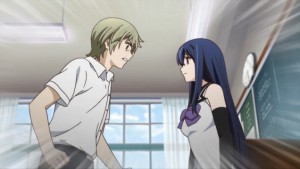
Why I Watched It: I liked the premise, that a boy meets a girl that looks like his childhood friend who died years ago. That this was a science fiction show and the girl escaped a research lab was known to me before I watched it, but it could have been a slice-of-life series and I still would have given it a shot.
What I Thought: The opening credits make this look like a more pulse-pounding and sinister show than I expected. I’m a little put off by what looks to be a predominantly female cast with a single male lead. In anime intended for a primarily male audience, this frequently means there will be a certain amount of fanservice and all the girls will end up falling in love with the main character. And in the first episode there are definitely some fanservice shots, though they are not nearly as egregious as other shows. Fortunately Ryota is a sympathetic protagonist and the story between him and his childhood friend Kuroneko is engaging enough that I want to see what happens between him and her look-alike Kuroha Neko, who appears to be a scientifically created witch and part of a network of people who can predict when others will die.
Verdict: I will be watching it. There are enough tantalizing bits regarding Kuroha’s past and her special abilities that I want to see more (and she has to be Ryota’s childhood friend somehow even though she’s missing the moles on her body that his friend had).
Chaika – The Coffin Princess
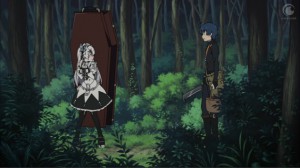
Why I Watched It: I wasn’t going to. I didn’t like the character designs and I didn’t like what I had heard of the main character, being a young teenage girl who only speaks in words and sentence fragments (presumably because it makes her adorably quirky). But I kept hearing about the carnivorous unicorn in the first episode so I figured it must be something awesome.
What I Thought: The unicorn wasn’t too shabby (actually a bit creepy right up until they fought it), but the setup where main character Chaika happens to meet super-powered siblings Toru and Akari and that they are willing to take a job from such a nutcase of a wizard as Chaika, is just a little too pat. I have trouble buying the fact the siblings are so broke as to be scrounging for food when they both possess a transformation ability that makes them superhumanly strong and immune to fear. Fortunately there are hints of a more complicated plot involving something that went down five years ago in a civil war, and mysterious faction that may or may not be on Chaika’s side.
Verdict: I might go back to this one if I have time or one of the series I intend to watch bombs out.
JoJo’s Bizarre Adventure: Stardust Crusaders
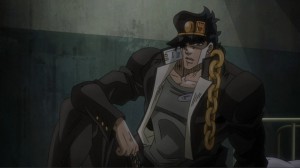 Why I Watched It: When I was very new to anime, the original JoJo’s Bizarre Adventure OAV series was one of the few that really stuck in my mind due to the crazy combination of the extremely manly art style, the level of violence, and the Stands, which I can’t really describe as anything other than mystic inner selves named after tarot cards. They’re a lot like the Personas in the Persona series, but predate them by several years.
Why I Watched It: When I was very new to anime, the original JoJo’s Bizarre Adventure OAV series was one of the few that really stuck in my mind due to the crazy combination of the extremely manly art style, the level of violence, and the Stands, which I can’t really describe as anything other than mystic inner selves named after tarot cards. They’re a lot like the Personas in the Persona series, but predate them by several years.
What I Thought: I mostly watched this out of curiousity, since the original OAV series did not cover the first half of the Stardust Crusaders story arc so I started in the middle. It’s funny watching it because the story takes place in 1989, which was current day when the manga ran, but makes this a historical piece now. It’s exactly what I expected, even with stylized sound effects just like you would see in a manga panel, except animated. JoJo’s is completely unapologetic about its age and makes no effort to update itself. The manga has been running for over twenty-five years and knows what it is to the tune of 110 volumes and counting.
Verdict: It’s JoJo’s, which means a lot of muscly guys screaming at each other while fighting and I already know where the story’s going. It’s worth a look for someone who wants an introduction to one of Japan’s longest continually running manga series and the story arc is self-contained, but doesn’t offer much more than updated animation for someone who saw the earlier version.
M3: the dark metal
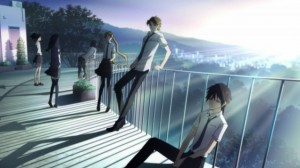 Why I Watched It: I like shows with a bit of mystery around them. Near future Tokyo is slowly being swallowed by a blackness called the Lightless Realm that consumes anyone who tries to explore it, and there is a strange song that comes from its guardians where if someone hears it they will die in nine days.
Why I Watched It: I like shows with a bit of mystery around them. Near future Tokyo is slowly being swallowed by a blackness called the Lightless Realm that consumes anyone who tries to explore it, and there is a strange song that comes from its guardians where if someone hears it they will die in nine days.
What I Thought: This show feels like it should always be taking place at night, because that’s when its most effective scenes are. The scenes in full daylight lose the feeling of menace that should be coming from the Lightless Realm and the mysterious Admonitions and Corpses that emerge from it. The show has a gender-balanced ensemble cast consisting of a special class of students who are being trained to eventually explore the zone and emerge alive thanks to new technology. However most of the first episode focuses around Akashi, who so far looks be talented, but relatively unsympathetic. By the end of the first episode we get a little bit of insight into what the Admonitions are, which is appropriately disturbing, and most of the cast hears a Corpse’s song.
Verdict: I will be watching it. No one in the cast has particularly won me over, but the atmosphere certainly did. I’d like to see what happens when they finally start exploration and what it is that they’ll find inside.
One Week Friends
 Why I Watched It: I liked the premise. It sounded very sweet. Kaori Fujimiya is a high school girl who loses memories of people who she wants to spend time with, who are important to her (barring family members), with the start of every Monday. This makes it impossible for her to make friends, but one boy, Yuuki Hase, picks up on her loneliness and resolves to become her friend every week.
Why I Watched It: I liked the premise. It sounded very sweet. Kaori Fujimiya is a high school girl who loses memories of people who she wants to spend time with, who are important to her (barring family members), with the start of every Monday. This makes it impossible for her to make friends, but one boy, Yuuki Hase, picks up on her loneliness and resolves to become her friend every week.
What I Thought: OMG the feels. Kaori and Yuuki are absolutely adorable together. The first episode covers the course of a week as they gradually and believably begin to become friends, and the animation easily picks up every bit of their awkward conversations as she tries to dance around her peculiar condition and Yuuki tries not to feel rejected. It’s an easy tug on the heartstrings, but the end of that first episode when Yuuki resolves to tell her “I want to be your friend” at the start of every week was so sweet. I’m not sure how the show will progress if Kaori is constantly resetting, but it’s definitely earned a place on my list.
Verdict: Must watch! End of story.
The World is Still Beautiful
 Why I Watched It: Shoujo (girls) comics are infrequently adapted into anime, and even though the character designs don’t quite do anything for me, I wanted to give this one a shot. The premise is that the Sun King conquered most of the world, but agreed to leave the Duchy of Rain alone in exchange for one of the duke’s daughters in marriage. Princess Nike loses a game of rock-paper-scissors against her sisters and is prompted shipped off to marry a king she has never met, but the king turns out to be a boy younger than she is and she’s no shrinking violet.
Why I Watched It: Shoujo (girls) comics are infrequently adapted into anime, and even though the character designs don’t quite do anything for me, I wanted to give this one a shot. The premise is that the Sun King conquered most of the world, but agreed to leave the Duchy of Rain alone in exchange for one of the duke’s daughters in marriage. Princess Nike loses a game of rock-paper-scissors against her sisters and is prompted shipped off to marry a king she has never met, but the king turns out to be a boy younger than she is and she’s no shrinking violet.
What I Thought: It turned out to be a sillier show than I thought it would be, even breaking the fourth wall at one point. Nike gets into what I would consider horrible situations if it had been anyone else, but they get played for laughs and she never takes anything too badly. It helps that she can command the weather and she’s not afraid to use it. I like that she has a lot of confidence and isn’t overly girly, which is atypical of shoujo heroines. The boy king is only introduced at the very end of the episode, so it’s not possible to see what their relationship is going to be like, but he looks just young enough for it to feel a little squicky. According to Wikipedia he’s supposed to be 15 but he looks like he’s 12.
Verdict: I’m going to keep watching this one to see if it gets better. It’s hard to judge a romantic comedy when half the couple has barely been on screen by the end of the first episode.
Conspicuously missing
Knights of Sidonia – The most serious science fiction offering of the season, featuring massive colony ships, genetically engineered humans to better survive in a harsh environment, and giant robots (okay, maybe that part isn’t so serious) is a Netflix exclusive and will not be appearing in the US until Summer 2014. In an era of simulcasting that seems a terrible business decision. By the time it makes its way over here fans will be talking about the next season of shows.
 Laurie Tom is a fantasy and science fiction writer based in southern California. Since she was a kid she has considered books, video games, and anime in roughly equal portions to be her primary source of entertainment. Laurie is a previous grand prize winner of Writers of the Future and since then her work has been published inGalaxy’s Edge, Penumbra, and Solaris Rising: The New Solaris Book of Science Fiction.
Laurie Tom is a fantasy and science fiction writer based in southern California. Since she was a kid she has considered books, video games, and anime in roughly equal portions to be her primary source of entertainment. Laurie is a previous grand prize winner of Writers of the Future and since then her work has been published inGalaxy’s Edge, Penumbra, and Solaris Rising: The New Solaris Book of Science Fiction.

